A Critical Review: Microcredit's False Hopes and Real Possibilities
VerifiedAdded on 2023/06/15
|6
|983
|195
Essay
AI Summary
This essay provides a critical analysis of microcredit, focusing on its effectiveness in combating global poverty and its alignment with neoliberal policies. It examines the Grameen Style Initiative and its limitations, highlighting its focus on inflation control over job creation and the reduction of government subsidies. The analysis acknowledges the contributions of the Grameen Model in providing financial services to the poor, targeting women as loan recipients, and developing alternatives to traditional collateral. However, it raises concerns about lending rates and the challenges faced by micro-enterprises in the absence of adequate infrastructure and vibrant domestic markets. The essay concludes by emphasizing the need to embed microcredit within a broader development strategy that promotes growth, employment, and poverty reduction, drawing lessons from developmental state economic models.
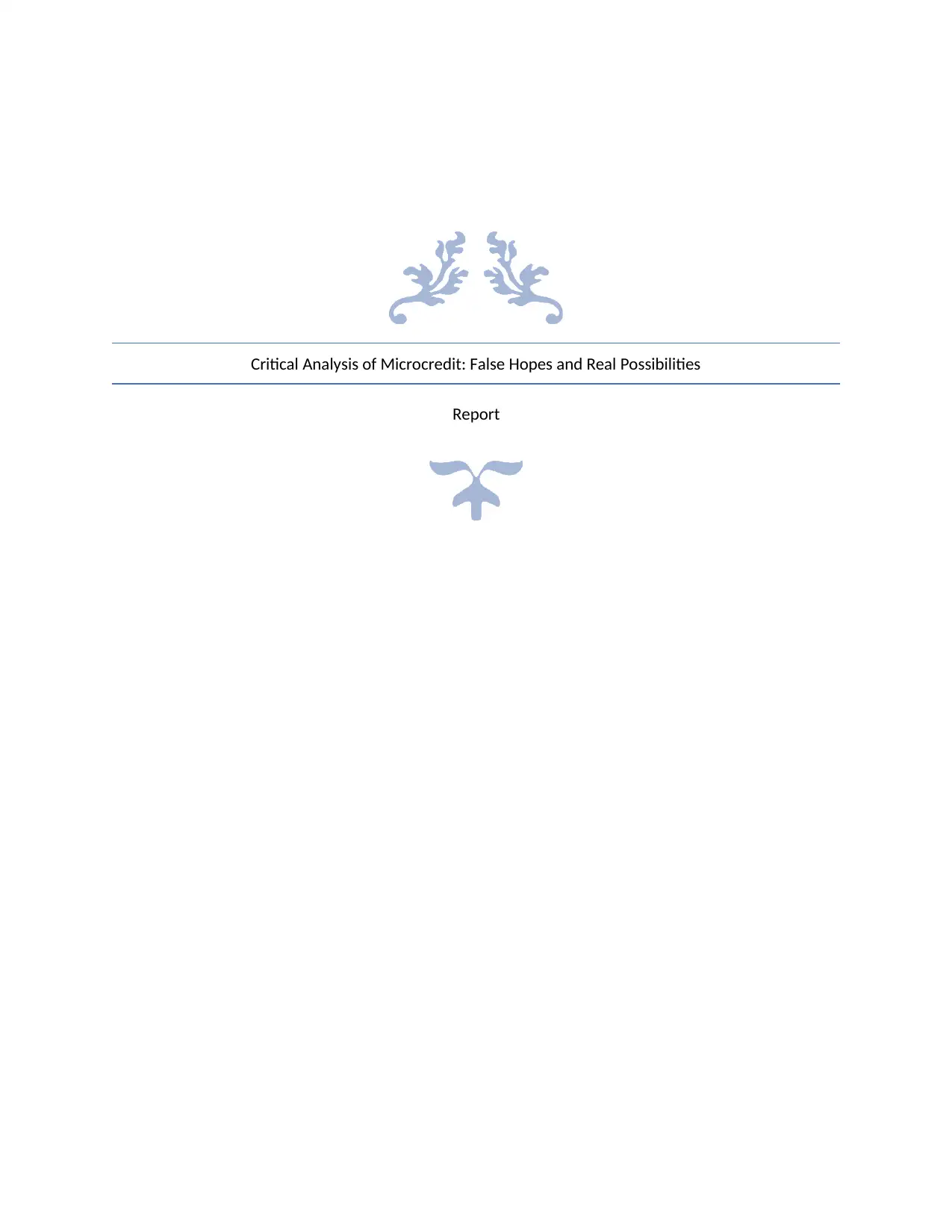
Critical Analysis of Microcredit: False Hopes and Real Possibilities
Report
Report
Paraphrase This Document
Need a fresh take? Get an instant paraphrase of this document with our AI Paraphraser
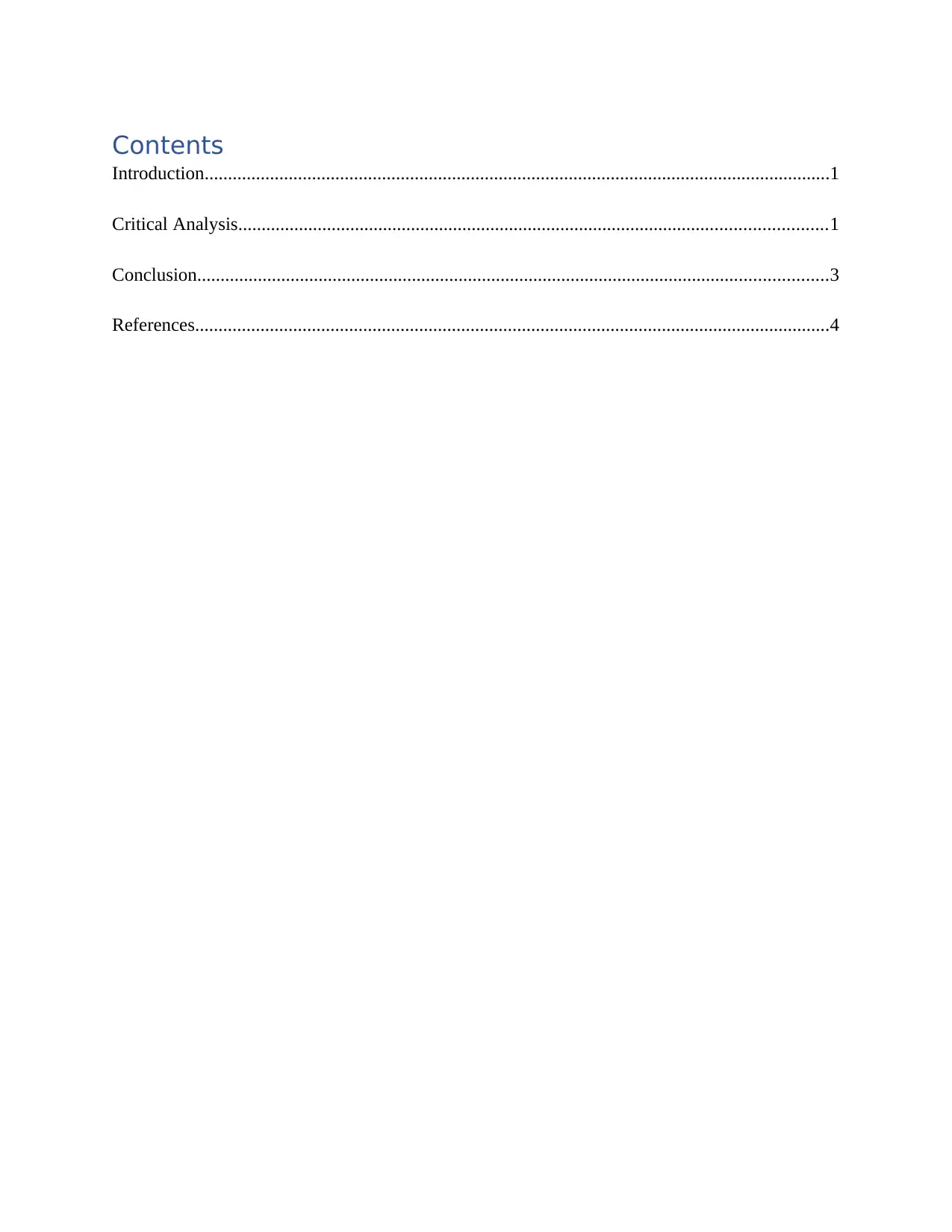
Contents
Introduction......................................................................................................................................1
Critical Analysis..............................................................................................................................1
Conclusion.......................................................................................................................................3
References........................................................................................................................................4
Introduction......................................................................................................................................1
Critical Analysis..............................................................................................................................1
Conclusion.......................................................................................................................................3
References........................................................................................................................................4
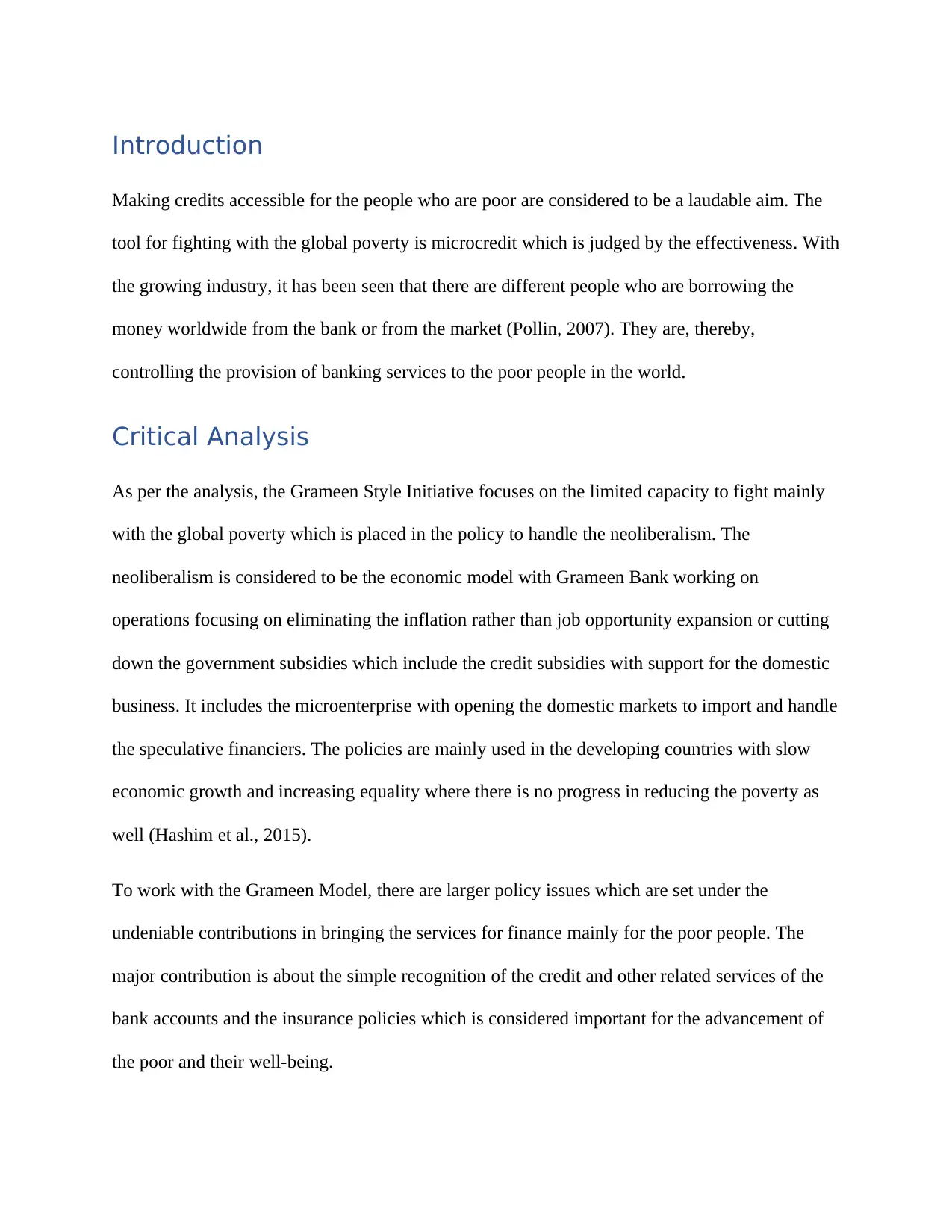
Introduction
Making credits accessible for the people who are poor are considered to be a laudable aim. The
tool for fighting with the global poverty is microcredit which is judged by the effectiveness. With
the growing industry, it has been seen that there are different people who are borrowing the
money worldwide from the bank or from the market (Pollin, 2007). They are, thereby,
controlling the provision of banking services to the poor people in the world.
Critical Analysis
As per the analysis, the Grameen Style Initiative focuses on the limited capacity to fight mainly
with the global poverty which is placed in the policy to handle the neoliberalism. The
neoliberalism is considered to be the economic model with Grameen Bank working on
operations focusing on eliminating the inflation rather than job opportunity expansion or cutting
down the government subsidies which include the credit subsidies with support for the domestic
business. It includes the microenterprise with opening the domestic markets to import and handle
the speculative financiers. The policies are mainly used in the developing countries with slow
economic growth and increasing equality where there is no progress in reducing the poverty as
well (Hashim et al., 2015).
To work with the Grameen Model, there are larger policy issues which are set under the
undeniable contributions in bringing the services for finance mainly for the poor people. The
major contribution is about the simple recognition of the credit and other related services of the
bank accounts and the insurance policies which is considered important for the advancement of
the poor and their well-being.
Making credits accessible for the people who are poor are considered to be a laudable aim. The
tool for fighting with the global poverty is microcredit which is judged by the effectiveness. With
the growing industry, it has been seen that there are different people who are borrowing the
money worldwide from the bank or from the market (Pollin, 2007). They are, thereby,
controlling the provision of banking services to the poor people in the world.
Critical Analysis
As per the analysis, the Grameen Style Initiative focuses on the limited capacity to fight mainly
with the global poverty which is placed in the policy to handle the neoliberalism. The
neoliberalism is considered to be the economic model with Grameen Bank working on
operations focusing on eliminating the inflation rather than job opportunity expansion or cutting
down the government subsidies which include the credit subsidies with support for the domestic
business. It includes the microenterprise with opening the domestic markets to import and handle
the speculative financiers. The policies are mainly used in the developing countries with slow
economic growth and increasing equality where there is no progress in reducing the poverty as
well (Hashim et al., 2015).
To work with the Grameen Model, there are larger policy issues which are set under the
undeniable contributions in bringing the services for finance mainly for the poor people. The
major contribution is about the simple recognition of the credit and other related services of the
bank accounts and the insurance policies which is considered important for the advancement of
the poor and their well-being.
⊘ This is a preview!⊘
Do you want full access?
Subscribe today to unlock all pages.

Trusted by 1+ million students worldwide
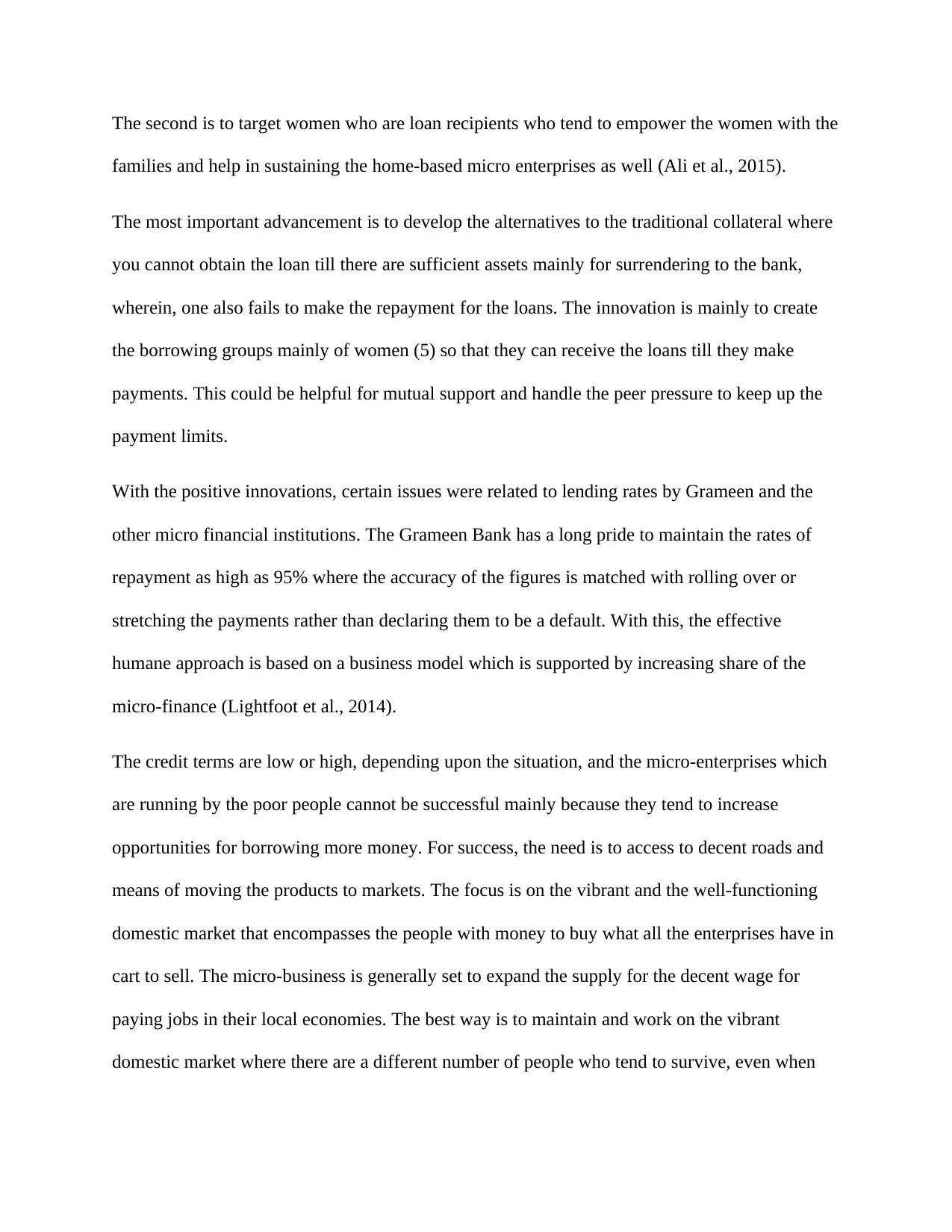
The second is to target women who are loan recipients who tend to empower the women with the
families and help in sustaining the home-based micro enterprises as well (Ali et al., 2015).
The most important advancement is to develop the alternatives to the traditional collateral where
you cannot obtain the loan till there are sufficient assets mainly for surrendering to the bank,
wherein, one also fails to make the repayment for the loans. The innovation is mainly to create
the borrowing groups mainly of women (5) so that they can receive the loans till they make
payments. This could be helpful for mutual support and handle the peer pressure to keep up the
payment limits.
With the positive innovations, certain issues were related to lending rates by Grameen and the
other micro financial institutions. The Grameen Bank has a long pride to maintain the rates of
repayment as high as 95% where the accuracy of the figures is matched with rolling over or
stretching the payments rather than declaring them to be a default. With this, the effective
humane approach is based on a business model which is supported by increasing share of the
micro-finance (Lightfoot et al., 2014).
The credit terms are low or high, depending upon the situation, and the micro-enterprises which
are running by the poor people cannot be successful mainly because they tend to increase
opportunities for borrowing more money. For success, the need is to access to decent roads and
means of moving the products to markets. The focus is on the vibrant and the well-functioning
domestic market that encompasses the people with money to buy what all the enterprises have in
cart to sell. The micro-business is generally set to expand the supply for the decent wage for
paying jobs in their local economies. The best way is to maintain and work on the vibrant
domestic market where there are a different number of people who tend to survive, even when
families and help in sustaining the home-based micro enterprises as well (Ali et al., 2015).
The most important advancement is to develop the alternatives to the traditional collateral where
you cannot obtain the loan till there are sufficient assets mainly for surrendering to the bank,
wherein, one also fails to make the repayment for the loans. The innovation is mainly to create
the borrowing groups mainly of women (5) so that they can receive the loans till they make
payments. This could be helpful for mutual support and handle the peer pressure to keep up the
payment limits.
With the positive innovations, certain issues were related to lending rates by Grameen and the
other micro financial institutions. The Grameen Bank has a long pride to maintain the rates of
repayment as high as 95% where the accuracy of the figures is matched with rolling over or
stretching the payments rather than declaring them to be a default. With this, the effective
humane approach is based on a business model which is supported by increasing share of the
micro-finance (Lightfoot et al., 2014).
The credit terms are low or high, depending upon the situation, and the micro-enterprises which
are running by the poor people cannot be successful mainly because they tend to increase
opportunities for borrowing more money. For success, the need is to access to decent roads and
means of moving the products to markets. The focus is on the vibrant and the well-functioning
domestic market that encompasses the people with money to buy what all the enterprises have in
cart to sell. The micro-business is generally set to expand the supply for the decent wage for
paying jobs in their local economies. The best way is to maintain and work on the vibrant
domestic market where there are a different number of people who tend to survive, even when
Paraphrase This Document
Need a fresh take? Get an instant paraphrase of this document with our AI Paraphraser
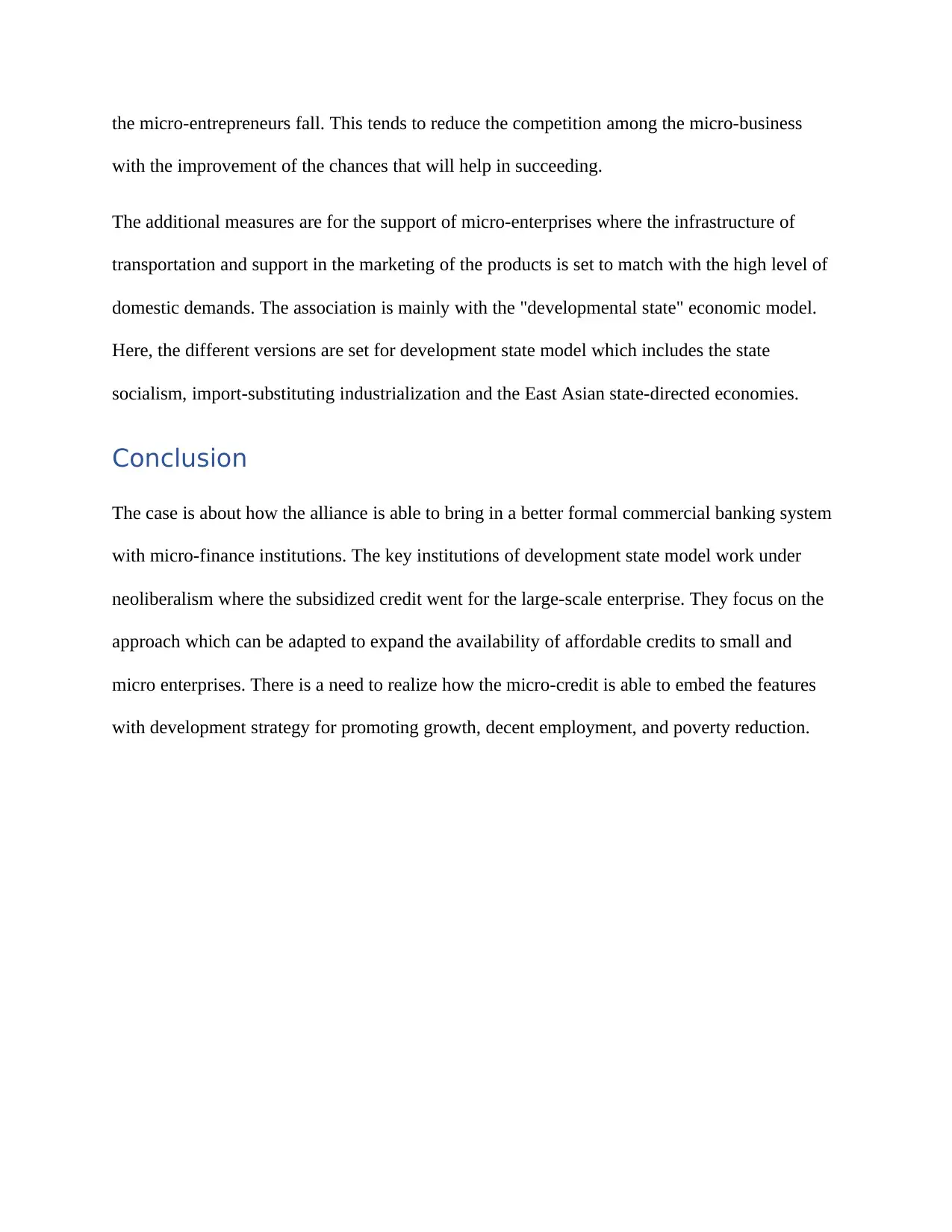
the micro-entrepreneurs fall. This tends to reduce the competition among the micro-business
with the improvement of the chances that will help in succeeding.
The additional measures are for the support of micro-enterprises where the infrastructure of
transportation and support in the marketing of the products is set to match with the high level of
domestic demands. The association is mainly with the "developmental state" economic model.
Here, the different versions are set for development state model which includes the state
socialism, import-substituting industrialization and the East Asian state-directed economies.
Conclusion
The case is about how the alliance is able to bring in a better formal commercial banking system
with micro-finance institutions. The key institutions of development state model work under
neoliberalism where the subsidized credit went for the large-scale enterprise. They focus on the
approach which can be adapted to expand the availability of affordable credits to small and
micro enterprises. There is a need to realize how the micro-credit is able to embed the features
with development strategy for promoting growth, decent employment, and poverty reduction.
with the improvement of the chances that will help in succeeding.
The additional measures are for the support of micro-enterprises where the infrastructure of
transportation and support in the marketing of the products is set to match with the high level of
domestic demands. The association is mainly with the "developmental state" economic model.
Here, the different versions are set for development state model which includes the state
socialism, import-substituting industrialization and the East Asian state-directed economies.
Conclusion
The case is about how the alliance is able to bring in a better formal commercial banking system
with micro-finance institutions. The key institutions of development state model work under
neoliberalism where the subsidized credit went for the large-scale enterprise. They focus on the
approach which can be adapted to expand the availability of affordable credits to small and
micro enterprises. There is a need to realize how the micro-credit is able to embed the features
with development strategy for promoting growth, decent employment, and poverty reduction.
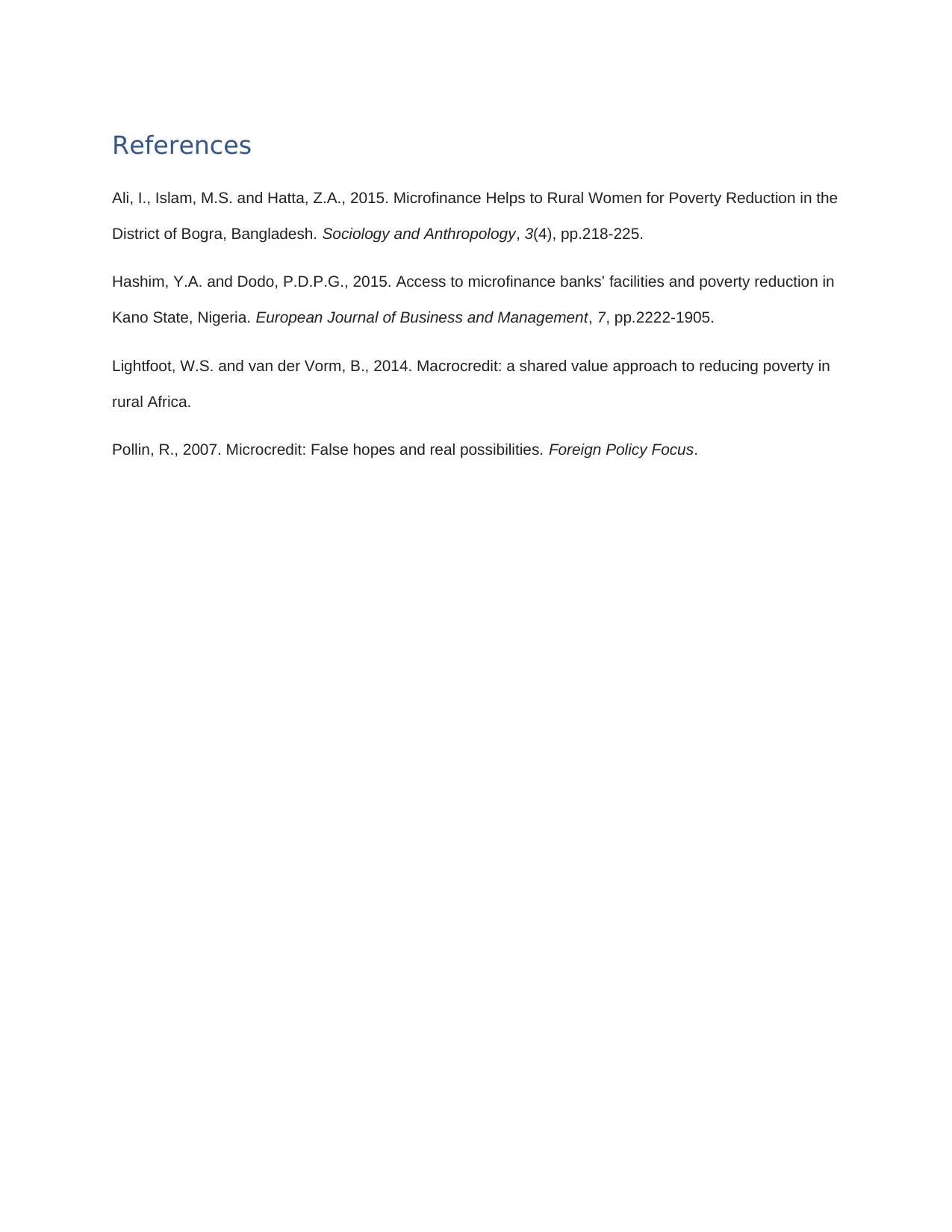
References
Ali, I., Islam, M.S. and Hatta, Z.A., 2015. Microfinance Helps to Rural Women for Poverty Reduction in the
District of Bogra, Bangladesh. Sociology and Anthropology, 3(4), pp.218-225.
Hashim, Y.A. and Dodo, P.D.P.G., 2015. Access to microfinance banks’ facilities and poverty reduction in
Kano State, Nigeria. European Journal of Business and Management, 7, pp.2222-1905.
Lightfoot, W.S. and van der Vorm, B., 2014. Macrocredit: a shared value approach to reducing poverty in
rural Africa.
Pollin, R., 2007. Microcredit: False hopes and real possibilities. Foreign Policy Focus.
Ali, I., Islam, M.S. and Hatta, Z.A., 2015. Microfinance Helps to Rural Women for Poverty Reduction in the
District of Bogra, Bangladesh. Sociology and Anthropology, 3(4), pp.218-225.
Hashim, Y.A. and Dodo, P.D.P.G., 2015. Access to microfinance banks’ facilities and poverty reduction in
Kano State, Nigeria. European Journal of Business and Management, 7, pp.2222-1905.
Lightfoot, W.S. and van der Vorm, B., 2014. Macrocredit: a shared value approach to reducing poverty in
rural Africa.
Pollin, R., 2007. Microcredit: False hopes and real possibilities. Foreign Policy Focus.
⊘ This is a preview!⊘
Do you want full access?
Subscribe today to unlock all pages.

Trusted by 1+ million students worldwide
1 out of 6
Your All-in-One AI-Powered Toolkit for Academic Success.
+13062052269
info@desklib.com
Available 24*7 on WhatsApp / Email
![[object Object]](/_next/static/media/star-bottom.7253800d.svg)
Unlock your academic potential
Copyright © 2020–2025 A2Z Services. All Rights Reserved. Developed and managed by ZUCOL.
